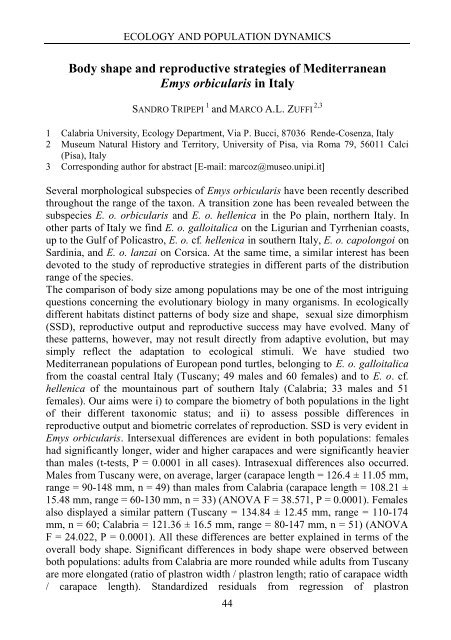Dear Attendees of the EMYS Symposium at Košice - Fauna Carpatica
Dear Attendees of the EMYS Symposium at Košice - Fauna Carpatica
Dear Attendees of the EMYS Symposium at Košice - Fauna Carpatica
You also want an ePaper? Increase the reach of your titles
YUMPU automatically turns print PDFs into web optimized ePapers that Google loves.
ECOLOGY AND POPULATION DYNAMICS<br />
Body shape and reproductive str<strong>at</strong>egies <strong>of</strong> Mediterranean<br />
Emys orbicularis in Italy<br />
SANDRO TRIPEPI 1 and MARCO A.L. ZUFFI 2,3<br />
1 Calabria University, Ecology Department, Via P. Bucci, 87036 Rende-Cosenza, Italy<br />
2 Museum N<strong>at</strong>ural History and Territory, University <strong>of</strong> Pisa, via Roma 79, 56011 Calci<br />
(Pisa), Italy<br />
3 Corresponding author for abstract [E-mail: marcoz@museo.unipi.it]<br />
Several morphological subspecies <strong>of</strong> Emys orbicularis have been recently described<br />
throughout <strong>the</strong> range <strong>of</strong> <strong>the</strong> taxon. A transition zone has been revealed between <strong>the</strong><br />
subspecies E. o. orbicularis and E. o. hellenica in <strong>the</strong> Po plain, nor<strong>the</strong>rn Italy. In<br />
o<strong>the</strong>r parts <strong>of</strong> Italy we find E. o. galloitalica on <strong>the</strong> Ligurian and Tyrrhenian coasts,<br />
up to <strong>the</strong> Gulf <strong>of</strong> Policastro, E. o. cf. hellenica in sou<strong>the</strong>rn Italy, E. o. capolongoi on<br />
Sardinia, and E. o. lanzai on Corsica. At <strong>the</strong> same time, a similar interest has been<br />
devoted to <strong>the</strong> study <strong>of</strong> reproductive str<strong>at</strong>egies in different parts <strong>of</strong> <strong>the</strong> distribution<br />
range <strong>of</strong> <strong>the</strong> species.<br />
The comparison <strong>of</strong> body size among popul<strong>at</strong>ions may be one <strong>of</strong> <strong>the</strong> most intriguing<br />
questions concerning <strong>the</strong> evolutionary biology in many organisms. In ecologically<br />
different habit<strong>at</strong>s distinct p<strong>at</strong>terns <strong>of</strong> body size and shape, sexual size dimorphism<br />
(SSD), reproductive output and reproductive success may have evolved. Many <strong>of</strong><br />
<strong>the</strong>se p<strong>at</strong>terns, however, may not result directly from adaptive evolution, but may<br />
simply reflect <strong>the</strong> adapt<strong>at</strong>ion to ecological stimuli. We have studied two<br />
Mediterranean popul<strong>at</strong>ions <strong>of</strong> European pond turtles, belonging to E. o. galloitalica<br />
from <strong>the</strong> coastal central Italy (Tuscany; 49 males and 60 females) and to E. o. cf.<br />
hellenica <strong>of</strong> <strong>the</strong> mountainous part <strong>of</strong> sou<strong>the</strong>rn Italy (Calabria; 33 males and 51<br />
females). Our aims were i) to compare <strong>the</strong> biometry <strong>of</strong> both popul<strong>at</strong>ions in <strong>the</strong> light<br />
<strong>of</strong> <strong>the</strong>ir different taxonomic st<strong>at</strong>us; and ii) to assess possible differences in<br />
reproductive output and biometric correl<strong>at</strong>es <strong>of</strong> reproduction. SSD is very evident in<br />
Emys orbicularis. Intersexual differences are evident in both popul<strong>at</strong>ions: females<br />
had significantly longer, wider and higher carapaces and were significantly heavier<br />
than males (t-tests, P = 0.0001 in all cases). Intrasexual differences also occurred.<br />
Males from Tuscany were, on average, larger (carapace length = 126.4 ± 11.05 mm,<br />
range = 90-148 mm, n = 49) than males from Calabria (carapace length = 108.21 ±<br />
15.48 mm, range = 60-130 mm, n = 33) (ANOVA F = 38.571, P = 0.0001). Females<br />
also displayed a similar p<strong>at</strong>tern (Tuscany = 134.84 ± 12.45 mm, range = 110-174<br />
mm, n = 60; Calabria = 121.36 ± 16.5 mm, range = 80-147 mm, n = 51) (ANOVA<br />
F = 24.022, P = 0.0001). All <strong>the</strong>se differences are better explained in terms <strong>of</strong> <strong>the</strong><br />
overall body shape. Significant differences in body shape were observed between<br />
both popul<strong>at</strong>ions: adults from Calabria are more rounded while adults from Tuscany<br />
are more elong<strong>at</strong>ed (r<strong>at</strong>io <strong>of</strong> plastron width / plastron length; r<strong>at</strong>io <strong>of</strong> carapace width<br />
/ carapace length). Standardized residuals from regression <strong>of</strong> plastron<br />
44



